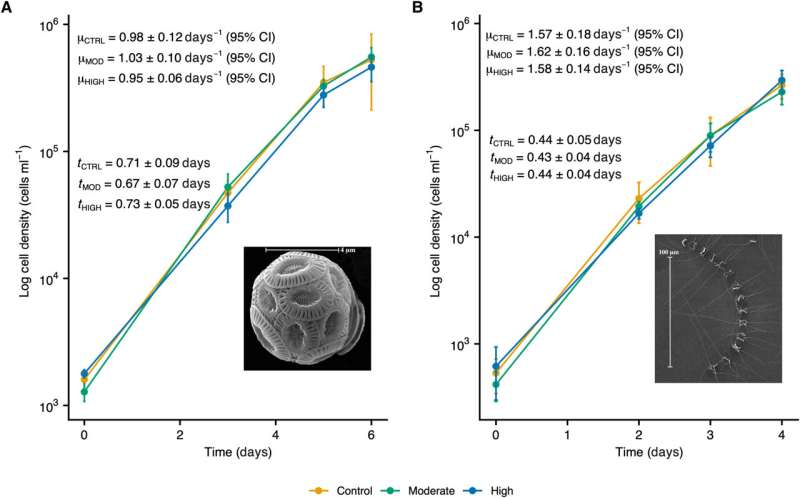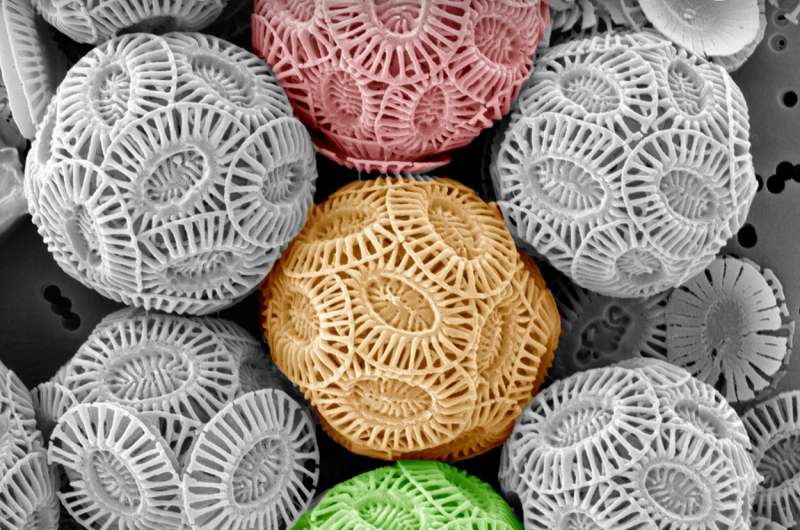The impact of ocean alkalinity enhancement on marine biota offers hope for carbon dioxide removal
Marine biologists are increasingly seeking methods to mitigate anthropogenic climate interference by implementing strategies for ocean carbon dioxide removal (CDR). Ocean alkalinity enhancement parameter is an abiotic approach aimed at carbon dioxide removal. Attempts to increase the carbon dioxide uptake capacity of the ocean can be established by dispersing pulverized mineral or dissolved alkali into the ocean surface.
Nevertheless, the impact of this action remains largely unexplored. In a new report now published in Science Advances, James A. Gately and a research team in ecology and development biology at the University of California, Santa Barbara, U.S., studied the impact of limestone-inspired alkalinity on the bioecology of two phytoplankton functional groups—the coccolithophore (single-celled) Emiliania huxleyi a producer of calcium carbonate, responsible for large-scale calcium carbonate production, and the diatom specimen Chaetoceros sp., a silica producer in modern oceans.
Emiliania huxleyi, a single-celled marine phytoplankton is illustrated on the cover page of the Science Advances issue, and the two taxa (coccolithophore and diatom) together showed a neutral response to limestone-inspired alkalization relative to their growth rate and elemental ratios. The team additionally noted abiotic precipitation, which removed nutrients and alkalinity from the solution to offer an understanding of biogeochemical and physiological responses to ocean alkalinity enhancement in order to provide evidence of its greater impact and its capacity to influence marine ecosystems.
The 2015 Paris Agreement: Carbon dioxide removal strategies on land and in the ocean
At the 2015 Paris Agreement relative to the International Panel on Climate Change’s Fifth Assessment Report, researchers and industry leaders set a goal to limit the increase in the average global temperature well below 2°C—above pre-industrial levels, while limiting temperature increases to 1.5°C above pre-industrial levels.
To meet this target, the panels suggest incorporating carbon dioxide removal approaches in the ocean much like on land, alongside emission reductions to achieve the required removal of 9 gigatons of CO2 per year. The process of ocean alkalinity enhancement or artificial ocean alkalinization, alongside enhanced/accelerated weathering offers an abiotic technology for ocean carbon dioxide removal. This protocol has received much attention due to its large scope of carbon storage to potentially mitigate ocean acidification.
Antacids for the oceans?
Ocean alkalinity enhancement is also known as ocean alkalinization and accelerated weathering; an abiotic ocean carbon dioxide removal process that facilitates large carbon storage potential with possible ecological benefits to mitigate ocean acidification. Using this technique, oceanographers aim to restore the alkalinity much like restoring alkalinity through rock weathering, which occurs naturally on Earth on geological time-scales.
The team deduce that increasing the total alkalinity via ocean alkalinity enhancement can permanently remove carbon dioxide to establish a quasi-natural method of restoring ecosystems for fragile habitats such as coral reefs affected by oceanic acidification. In this study, Gately and colleagues examined the biogeochemical and physiological response to limestone-inspired ocean alkalinity enhancement using two biogeochemically important representative species.

The impact of alkalinization on the carbonate system
During ocean alkalinity enhancement experiments, the starting conditions for both the E. huxleyi and Chaetoceros species were within the range of targeted model predicted scenarios. The total alkalinity differed during the experiments between the two biotic experiments with varying results for the two species due to their diverse nutritional uptake. pH values also increased in the biotic experiments, although this increase was more pronounced.
The scientists explored the trends in nutrient evolution and the physiological and biogeochemical responses of the two species. For example, the growth rates of the two species were well constrained and comparable to those regulated in moderate and high total alkalinity treatments.
Outlook
In this way, James Gately and colleagues conducted a range of experiments on the biological responses underlying changes in seawater carbonate chemistry, and pH focused on ocean alkalinity. The biogeochemistry responses to ocean alkalinity remain largely unknown. Adding alkalinity to the surface ocean can lock carbon dioxide into diverse forms of dissolved inorganic carbon to promote an influx of atmospheric carbon dioxide in the ocean for global carbon cycling.
While initial findings indicated that the limestone-inspired alkalinity enhancement had little effect on the physiology and biochemistry of the Coccolithophore and diatom physiology, the experiments only considered two species, and effects of alkalinity on this limited selection might occur on longer timescales.
The in-lab experiments provided steps toward understanding the oceanic ecosystems responses to ocean alkalinity enhancement. Further experiments should be conducted on phytoplankton communities and phytoplankton functional groups to explore the potential ecosystem impact of ocean alkalinity enhancement and evaluate the risks of additional carbon dioxide removal technologies.
More information:
James A. Gately et al, Coccolithophores and diatoms resilient to ocean alkalinity enhancement: A glimpse of hope? Science Advances (2023). DOI: 10.1126/sciadv.adg6066
© 2023 Science X Network
Citation:
The impact of ocean alkalinity enhancement on marine biota offers hope for carbon dioxide removal (2023, June 27)
retrieved 27 June 2023
from https://phys.org/news/2023-06-impact-ocean-alkalinity-marine-biota.html
This document is subject to copyright. Apart from any fair dealing for the purpose of private study or research, no
part may be reproduced without the written permission. The content is provided for information purposes only.

Marine biologists are increasingly seeking methods to mitigate anthropogenic climate interference by implementing strategies for ocean carbon dioxide removal (CDR). Ocean alkalinity enhancement parameter is an abiotic approach aimed at carbon dioxide removal. Attempts to increase the carbon dioxide uptake capacity of the ocean can be established by dispersing pulverized mineral or dissolved alkali into the ocean surface.
Nevertheless, the impact of this action remains largely unexplored. In a new report now published in Science Advances, James A. Gately and a research team in ecology and development biology at the University of California, Santa Barbara, U.S., studied the impact of limestone-inspired alkalinity on the bioecology of two phytoplankton functional groups—the coccolithophore (single-celled) Emiliania huxleyi a producer of calcium carbonate, responsible for large-scale calcium carbonate production, and the diatom specimen Chaetoceros sp., a silica producer in modern oceans.
Emiliania huxleyi, a single-celled marine phytoplankton is illustrated on the cover page of the Science Advances issue, and the two taxa (coccolithophore and diatom) together showed a neutral response to limestone-inspired alkalization relative to their growth rate and elemental ratios. The team additionally noted abiotic precipitation, which removed nutrients and alkalinity from the solution to offer an understanding of biogeochemical and physiological responses to ocean alkalinity enhancement in order to provide evidence of its greater impact and its capacity to influence marine ecosystems.
The 2015 Paris Agreement: Carbon dioxide removal strategies on land and in the ocean
At the 2015 Paris Agreement relative to the International Panel on Climate Change’s Fifth Assessment Report, researchers and industry leaders set a goal to limit the increase in the average global temperature well below 2°C—above pre-industrial levels, while limiting temperature increases to 1.5°C above pre-industrial levels.
To meet this target, the panels suggest incorporating carbon dioxide removal approaches in the ocean much like on land, alongside emission reductions to achieve the required removal of 9 gigatons of CO2 per year. The process of ocean alkalinity enhancement or artificial ocean alkalinization, alongside enhanced/accelerated weathering offers an abiotic technology for ocean carbon dioxide removal. This protocol has received much attention due to its large scope of carbon storage to potentially mitigate ocean acidification.
Antacids for the oceans?
Ocean alkalinity enhancement is also known as ocean alkalinization and accelerated weathering; an abiotic ocean carbon dioxide removal process that facilitates large carbon storage potential with possible ecological benefits to mitigate ocean acidification. Using this technique, oceanographers aim to restore the alkalinity much like restoring alkalinity through rock weathering, which occurs naturally on Earth on geological time-scales.
The team deduce that increasing the total alkalinity via ocean alkalinity enhancement can permanently remove carbon dioxide to establish a quasi-natural method of restoring ecosystems for fragile habitats such as coral reefs affected by oceanic acidification. In this study, Gately and colleagues examined the biogeochemical and physiological response to limestone-inspired ocean alkalinity enhancement using two biogeochemically important representative species.

The impact of alkalinization on the carbonate system
During ocean alkalinity enhancement experiments, the starting conditions for both the E. huxleyi and Chaetoceros species were within the range of targeted model predicted scenarios. The total alkalinity differed during the experiments between the two biotic experiments with varying results for the two species due to their diverse nutritional uptake. pH values also increased in the biotic experiments, although this increase was more pronounced.
The scientists explored the trends in nutrient evolution and the physiological and biogeochemical responses of the two species. For example, the growth rates of the two species were well constrained and comparable to those regulated in moderate and high total alkalinity treatments.
Outlook
In this way, James Gately and colleagues conducted a range of experiments on the biological responses underlying changes in seawater carbonate chemistry, and pH focused on ocean alkalinity. The biogeochemistry responses to ocean alkalinity remain largely unknown. Adding alkalinity to the surface ocean can lock carbon dioxide into diverse forms of dissolved inorganic carbon to promote an influx of atmospheric carbon dioxide in the ocean for global carbon cycling.
While initial findings indicated that the limestone-inspired alkalinity enhancement had little effect on the physiology and biochemistry of the Coccolithophore and diatom physiology, the experiments only considered two species, and effects of alkalinity on this limited selection might occur on longer timescales.
The in-lab experiments provided steps toward understanding the oceanic ecosystems responses to ocean alkalinity enhancement. Further experiments should be conducted on phytoplankton communities and phytoplankton functional groups to explore the potential ecosystem impact of ocean alkalinity enhancement and evaluate the risks of additional carbon dioxide removal technologies.
More information:
James A. Gately et al, Coccolithophores and diatoms resilient to ocean alkalinity enhancement: A glimpse of hope? Science Advances (2023). DOI: 10.1126/sciadv.adg6066
© 2023 Science X Network
Citation:
The impact of ocean alkalinity enhancement on marine biota offers hope for carbon dioxide removal (2023, June 27)
retrieved 27 June 2023
from https://phys.org/news/2023-06-impact-ocean-alkalinity-marine-biota.html
This document is subject to copyright. Apart from any fair dealing for the purpose of private study or research, no
part may be reproduced without the written permission. The content is provided for information purposes only.
